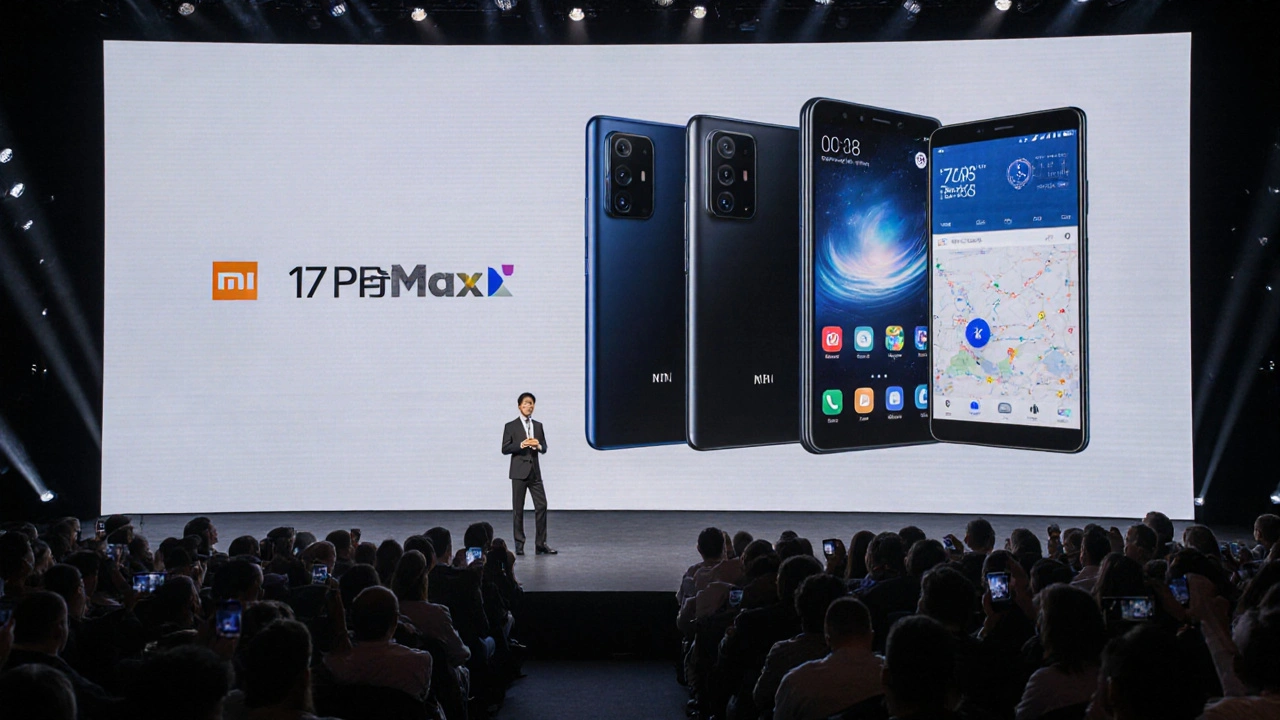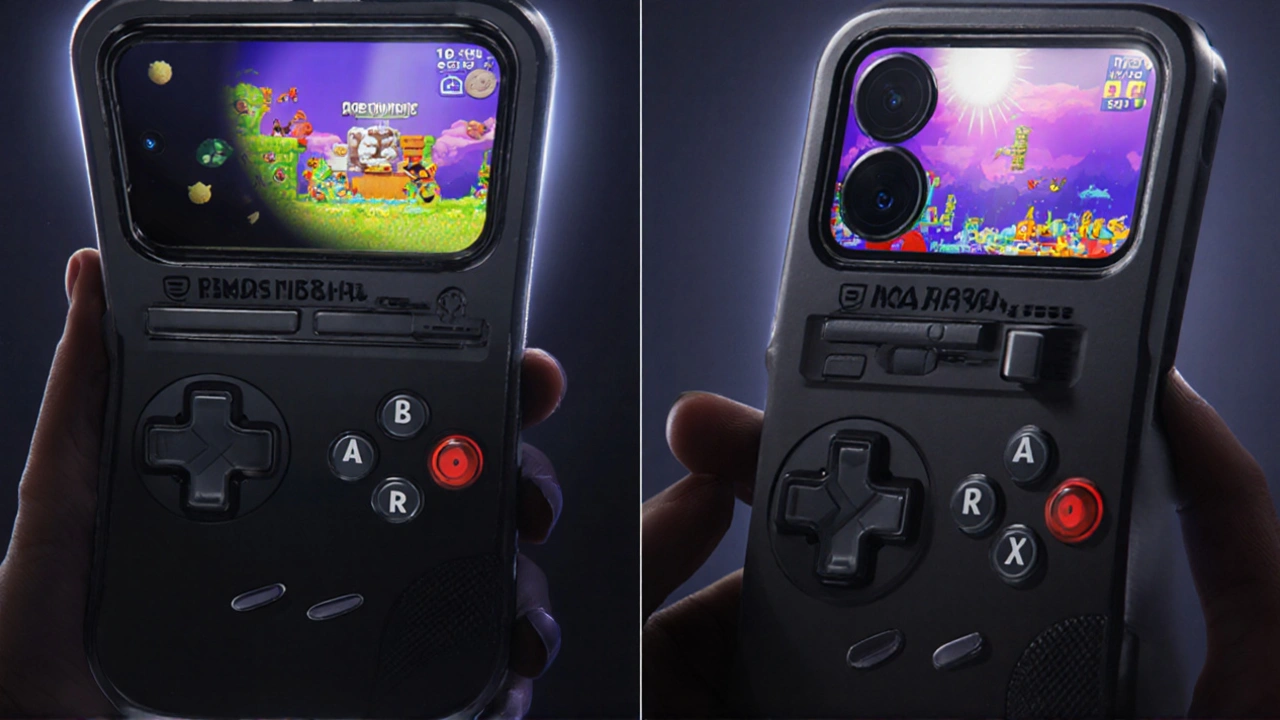Xiaomi 17 Pro Max unveiled with dual‑screen design and Snapdragon 8 Elite
 Sep, 27 2025
Sep, 27 2025
Design, display and the secondary screen
When Xiaomi announced the 17 Pro Max in September 2025, the first thing that caught eyes was the dual-screen concept. The primary display is a 6.9‑inch AMOLED panel with a 20:9 aspect ratio and QHD resolution of 1220 × 2656 pixels. At 463 ppi the screen feels razor‑sharp, whether you’re scrolling social feeds or watching 4K video.
The twist is the back‑mounted secondary screen. Earlier Xiaomi models used a tiny strip or a simple notification panel, but the new version is larger and runs Android UI elements independently. Users can toggle music controls, check calendar alerts, or run a mini‑camera view without waking the main screen. The rear panel is protected by Corning Gorilla Glass Victus, making it durable while still keeping the phone thinner than many rivals.
Weight is another surprise. Despite housing a 7500 mAh battery and two displays, Xiaomi managed to keep the device lighter than Apple’s iPhone 17 Pro Max, thanks to a magnesium‑aluminium alloy frame and careful internal layout. The phone feels solid in hand but not cumbersome, an advantage for people who carry their phone all day.

Performance, battery and camera capabilities
Under the hood lives the Snapdragon 8 Elite Gen 5, the first Android flagship chip to hit the market this year. Paired with 16 GB of LPDDR5X RAM, the 17 Pro Max handles heavy gaming, multi‑app multitasking and AI‑driven photo processing without a hiccup. Storage comes in three flavors – 256 GB, 512 GB and a whopping 1 TB – all using UFS 4.0 for lightning‑fast read/write speeds.
Battery life is a headline feature. A 7500 mAh cell, combined with LTPO OLED technology that adjusts refresh rate from 1 Hz up to 120 Hz, stretches usage well beyond a full day of screen‑on time, even for power users who stream video, play games and run background sync. Xiaomi’s proprietary thermal management system spreads heat across a graphite‑based heat pipe, keeping the processor cool during sustained workloads. Benchmarks show the phone outpacing the Samsung Galaxy S25 Ultra and even the newest Pixel models, though occasional throttling can occur under extreme stress.
Photography remains a strong suit thanks to the continued partnership with Leica. The rear camera module includes a 108 MP main sensor, a 13 MP ultra‑wide lens and a 10 MP periscope telephoto unit with 5× optical zoom. Leica’s colour science gives images a natural look with rich contrast, and the secondary screen can act as a viewfinder for selfies taken with the rear cameras, a quirky but handy feature.
Software-wise, the device ships with MIUI 14 based on Android 15. MIUI adds a dedicated “Dual‑Screen” mode that lets you assign apps to the rear display, similar to a small tablet experience. There’s also a “Power‑Saver” profile that caps the refresh rate and dims the secondary screen to extend battery life further.
- Primary display: 6.9‑inch AMOLED, QHD, 463 ppi.
- Secondary display: 2.5‑inch OLED, functional UI for notifications and shortcuts.
- Processor: Snapdragon 8 Elite Gen 5.
- RAM/Storage: 16 GB RAM, up to 1 TB UFS 4.0.
- Battery: 7500 mAh with LTPO, lasts over 24 hours on mixed use.
- Camera: 108 MP main + 13 MP ultra‑wide + 10 MP periscope (Leica partnership).
The 17 series also includes a smaller 17 model with a 6.3‑inch screen and a 7000 mAh battery, weighing just 191 g, and a mid‑range 17 Pro that sits between the standard and Pro Max in terms of specs. This tiered approach gives consumers a clear upgrade path without forcing them into the top‑tier price bracket.
Overall, the Xiaomi 17 Pro Max positions the company as a genuine contender in the premium smartphone arena. By mixing a bold dual‑screen design, top‑tier performance and a Leica‑branded camera system, Xiaomi offers an alternative to Apple and Samsung that feels fresh rather than a copy. The real test will be whether consumers embrace the rear screen in daily life, but early hands‑on reports suggest that the feature adds genuine convenience, especially for multitaskers and media lovers.

Satpal Singh
September 27, 2025 AT 06:06Xiaomi's dual‑screen approach is indeed novel; the engineering challenges of integrating a rear OLED while maintaining a lightweight form factor are noteworthy. The use of a magnesium‑aluminium alloy frame demonstrates thoughtful material selection. A 7500 mAh battery combined with LTPO technology should provide ample endurance for most users. Overall, the specifications suggest a well‑balanced flagship that merits attention.
Devendra Pandey
September 27, 2025 AT 21:06One could argue that adding a secondary screen merely shifts attention rather than solving multitasking fatigue; the device may become a symbol of excess rather than efficiency. The philosophical cost of constant visual stimuli is often overlooked in such hype.
manoj jadhav
October 9, 2025 AT 10:53The Xiaomi 17 Pro Max arrives as a bold statement in a market saturated with incremental upgrades, and it does not shy away from experimentation! A dual‑screen architecture, especially one that places a functional OLED on the back, challenges the conventional single‑display paradigm, provoking both curiosity and skepticism. From a hardware standpoint, the Snapdragon 8 Elite Gen 5, coupled with 16 GB of LPDDR5X RAM, offers a compute platform that rivals any contemporary flagship, ensuring smooth gameplay and AI processing without noticeable lag. The 7500 mAh battery, guarded by Gorilla Glass Victus, promises extended uptime, while the LTPO panel intelligently modulates refresh rates from 1 Hz to 120 Hz, conserving energy during idle moments. Thermal management, facilitated by a graphite‑based heat pipe, spreads heat efficiently, which is essential when the device sustains high‑intensity tasks such as 4K video rendering or prolonged gaming sessions. Photography enthusiasts will appreciate the Leica‑tuned 108 MP sensor, the ultra‑wide 13 MP lens, and the periscope telephoto offering 5× optical zoom, delivering versatility across lighting conditions. Moreover, the rear screen can serve as a viewfinder for rear‑camera selfies, an unconventional yet practical solution for content creators who crave higher resolution images without compromising ergonomics. Software integration through MIUI 14’s Dual‑Screen mode enables users to allocate specific apps to the back display, effectively creating a miniature tablet experience that can boost productivity. Critics may point out that the additional screen could introduce new failure points, yet Xiaomi’s choice of Corning Gorilla Glass Victus suggests a commitment to durability that mitigates such concerns. The device’s weight, surprisingly lighter than the iPhone 17 Pro Max despite the larger battery, attests to the effectiveness of the magnesium‑aluminium alloy chassis in balancing robustness with handheld comfort. From a cultural perspective, the device reflects a shift toward multi‑modal interaction, aligning with user habits that demand simultaneous communication, media consumption, and work tasks. Economically, the tiered lineup-including the smaller 17 model and the mid‑range 17 Pro-offers price points that could attract a broader audience, preventing the Pro Max from becoming an exclusive luxury item. Nevertheless, the real test lies in everyday adoption; will consumers find the rear screen indispensable or merely a novelty that fades after the initial excitement? Early hands‑on impressions suggest a steep learning curve but also highlight genuine convenience for multitaskers, especially when quick music controls or calendar alerts are accessible without waking the main display. In summary, the Xiaomi 17 Pro Max stands as a daring fusion of cutting‑edge hardware and inventive software, challenging the status quo while delivering tangible benefits to power users. If the market embraces this dual‑screen philosophy, we may witness a new chapter in smartphone design that blurs the line between phone and portable workstation.
saurav kumar
November 13, 2025 AT 03:13Both viewpoints highlight that novelty alone does not guarantee practicality.
Ashish Kumar
December 6, 2025 AT 06:46While the engineering feats are commendable, one must question whether such extravagance truly serves the common user, whose daily needs are far simpler than the spectacle presented herein; it definatly feels like a showcase rather than a solution for everyday life.